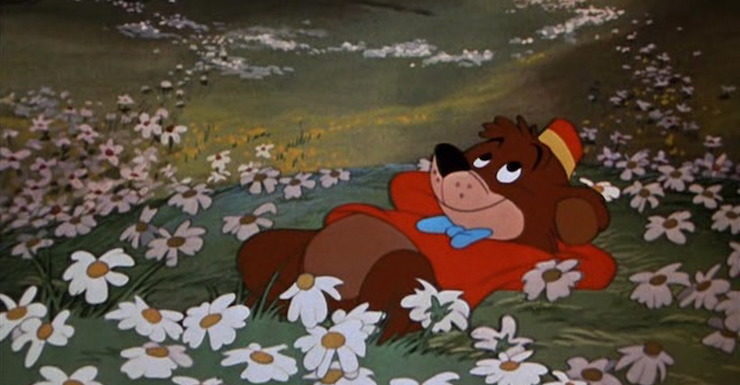What diabolical plot is being hatched in the brain of this poor demented duck?
As the United States emerged from World War II, Walt Disney felt increasingly desperate—and removed from the animation that had previously been his heart and soul. The majority of his films had been box office bombs, and even the cartoon shorts that had helped build the company before Snow White were facing increasing competition, especially from a director/animator called Chuck Jones over at rival Warner Bros. The money earned from producing training films for the Defense Department was gone, and distributor RKO Films refused to let Disney release Snow White and Dumbo on a yearly basis. Walt faced a crisis: his studio still didn’t have enough money to put together a full length animated picture, but the collections of cartoon shorts weren’t doing all that well either, strongly suggesting that the studio needed to return to longer features in order to survive.
What Walt Disney did have was a cartoon loosely based on the fairy tale Jack and the Beanstalk, featuring Mickey Mouse, Donald Duck and Goofy.
A bit too long for a regular cartoon short, it had been put into production before World War II, and then put on hold thanks first to a major strike by Disney artists, and then by the U.S. entry into World War II. RKO Films didn’t think much of it, but Mickey Mouse was still Mickey Mouse. Perhaps, Walt Disney thought, the studio and RKO Films could compromise. Instead of turning Mickey and the Beanstalk into a full length film, the studio could create a shorter, cheaper cartoon and package it with one of the other four short animated films then in various states of development at the studio—animated versions of The Wind in the Willows, The Legend of Sleepy Hollow, and Sinclair Lewis’ short story, “Little Bear Bongo.”
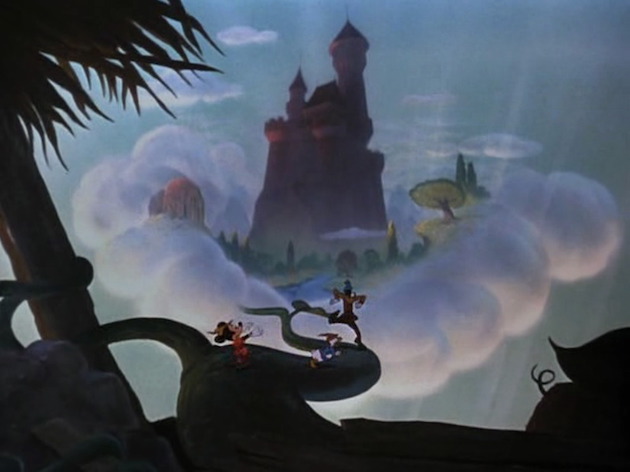
Even with the addition of a second cartoon, RKO Films was still unenthusiastic about the Mickey Mouse cartoon, so Disney tinkered still more, hiring popular ventriloquist Edgar Bergen and his popular puppets Charlie McCarthy (mostly without the double entendres, though with at least one good crack about working in radio) and Mortimer Snerd, then best known for their work on radio. Bergen would narrate the short, with asides from the puppets and, occasionally, Disney child star Luana Patten, but the real draw would not be Bergen’s voice, but rather an early opportunity for moviegoers to see Edgar Bergen and Charlie McCarthy on screen together. (The popular Charlie McCarthy television show would not air until 1949, a couple years after the release of this film.)
After more discussion, Disney decided to pair the Mickey Mouse short with the Bongo short, apparently under the idea that The Wind in the Willows could still become a full length feature (in the end, it was bundled with the Sleepy Hollow cartoon as The Adventures of Ichabod and Mr. Toad) and that Bongo was a better fit for the Mickey/Jack in the Beanstalk short. The two cartoons, they decided, would be linked together with a combination of live footage and an appearance from Jiminy Cricket, one of the more popular elements from Pinocchio.
This turned out to be a bit of a misstep: even with Jiminy Cricket making a bold attempt to link the two cartoons, and the script making an even bolder attempt to claim that the cartoons shared the same theme of “fun and fancy free,” as it turned out, the two cartoons were not at all a good match—and neither exactly met the theme of “fun and fancy free.” (By “fancy free,” as the narration clarifies, the film means “worry free,” which it isn’t, but we’ll get there.) The two cartoons were almost worlds apart in terms of artistry and interest (which is my quiet way of suggesting that you fast forward to the second half, unless you are really into bear slapping, which you might be), and both—presumably unintentionally—make a good case for arguing that the world is a terrible, unfair place, with happiness coming only from technology and magic. And although Jiminy Cricket isn’t exactly bad in this role, as it turns out, the character works much better as a conscience than as a character trying to spread cheer and crash parties.
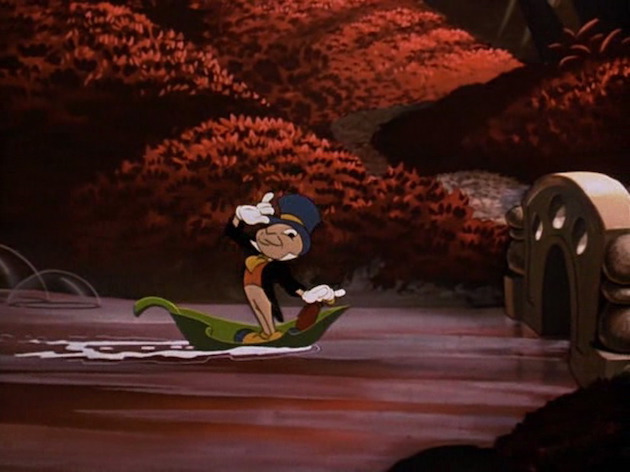
The film starts out simply enough, with Jiminy Cricket sailing into view in what looks like a nice outdoor landscape, but which turns out to be an indoor setting, singing some material recycled from Pinocchio, and urging everyone to stop worrying so much and just take life the way he does—fun and fancy free. The cricket cheerfully tells us that the end of the world has been coming since 1903, which MIGHT BE WHY WE’RE WORRIED, CRICKET, and also, may I just note that your carefree approach to life nearly gets you killed by a cat a few frames after this?
I do, however, have to give credit to the background artists in this section, who took the time to draw and ink every letter of a newspaper appearing in the background—almost as if they could foresee that at some point in the future, this image would not just simply rush by movie theatre audiences, but be paused on a big screen TV.
Meanwhile, a less impressed by background art Jiminy Cricket, still telling us that all we really need to do in life is relax and stop worrying about it, has encountered a dismal doll and an even more dismal teddy bear, both of which look ready to leap up and kill the first human they encounter. THIS IS ALSO WHY WE ARE WORRIED, CRICKET. Jiminy decides that he might as well try to cheer up the doll and the teddy bear by putting on Bongo, a musical story told and sung by Dinah Shore, and despite all of the time I’ve spent writing about this introduction, I really think the film would have been better—or at least less disturbing and mildly hypocritical—if it had just leapt right into the cartoon from the beginning.
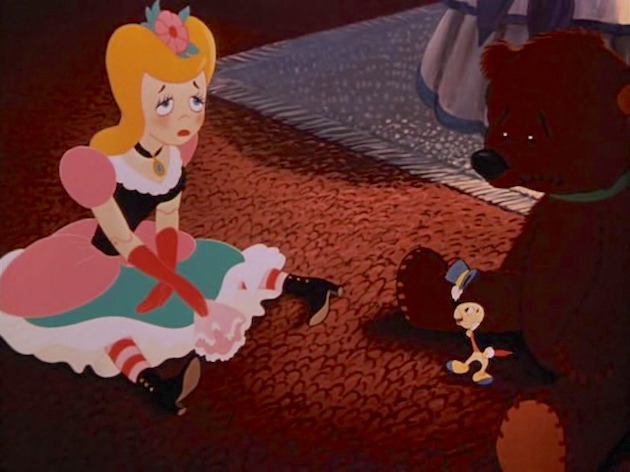
Not that the cartoon itself is one of Disney’s highlights—perhaps because Walt Disney himself, busy with other concerns, apparently took very little interest in it, and did not do his usual critiques of storyboards, scripts and concept art. It tells the story of Bongo, a circus bear who is not leading a fun and fancy free life, but rather a sad life as an imprisoned circus bear, bouncing (quite literally) between the joy of performing for happy circus crowds to the despair of getting chained up and put into his little Bongo prison, filled with Bongo posters and a cute little bed and some toys, but still, a prison. Imprisonment starts to get to Bongo, and in a change from the original story, he pulls apart the bars of his prison and leaps out—prudently taking his little unicycle and some publicity material with him—to freedom.
At first, all seems well, despite the rather major issues that (a) Bongo looks more like a teddy bear than an actual wild bear, and yet, none of the more realistic looking animals he encounters seems to have a problem with this, (b) Bongo can’t climb a tree, so all of the little animals are laughing at him, (c) several of the animation cels appear to be tracings from earlier work (notably Bambi, but also some scenes from Snow White and the Seven Dwarfs), and (d) Bongo mostly looks like a rather terrifying teddy bear stalking the forest instead of a real bear, a feeling only amplified when the actual bear gets there. And, although Dinah Shore has assured us that nights in the forest are delightful and peaceful, Bongo has a dreadful night of insects, bats, and howling coyotes and lightning and thunder, ending his night shivering.
The next day, after falling behind a waterfall, Bongo catches sight of another teddy bear an actual wild bear, conveniently wearing a flower on her head to let alert viewers—if any are left at this point—realize that she’s a girl. The girl bear—oh, let’s just go ahead and call her Lulubelle, although Dinah Shore won’t give us this helpful information for several more painful minutes—appears to have learned the basics on How To Seduce Bears from Bambi, treating us to some excruciating moments of coy looks through long lashes, giggles, and running away, forcing Bongo to chase her on his little unicycle.
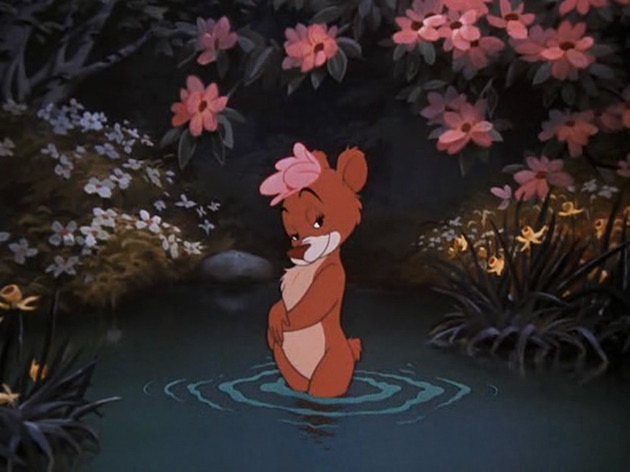
I said that Bongo and Lulubelle look like teddy bears running around the forest, but I said that only because that was before two cupid bears show up, looking as if they’d bounced right out of a Build-a-Bear catalog. Sure, technically the short predates the company, but let’s not rule out time travelling. The cupid bears, amazingly enough, manage to turn this all into something still more treacly, as the cupid bears put heart glasses on Bongo and then everyone floats around clouds trying to avoid love arrows and golden hearts, as you do, making it almost a relief when a Bad Bear shows up to get us started with some hard hitting bear slapping.
You read that right: as Dinah Shore explains to us, when bears are in love, they always say it with a slap. Or sing it with a slap, since shortly after the arrival of evil Bad Bear Lockjaw, the less evil wild bears have a little square dance and song about it:
“When a bird loves a bird, he can Twitter,
When a puppy falls in love, he can yap
Every pigeon likes to coo,
when he says I love you,
But a bear likes to say it
with a slap!”
and goes on to say –
“You can ask any bear
oh there’s nothing to compare
with a love tap strong or weak.”
Illustrating the concept, one bear stalks another bear, then hits her, lifts her up, whirls her around and then LOVE.
Also, slapping.
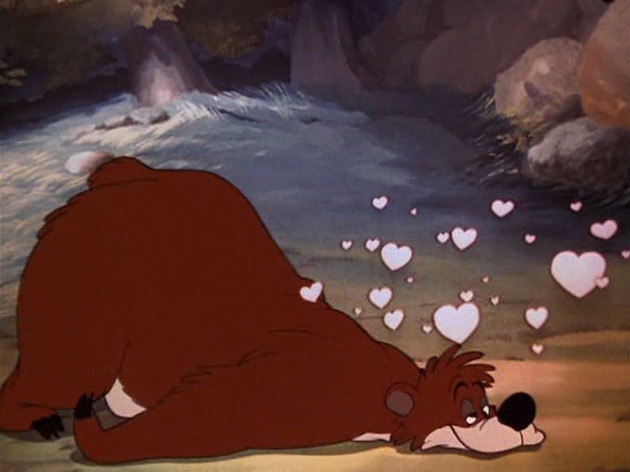
I’m just going to leave this here, except to note that Lulubelle’s one brief moment of seizing control of her own love life is interrupted largely because she’s slapped the wrong bear by mistake.
Perhaps not surprisingly after all this, the only way these bears can get a happy ending is—naturally enough—through circus tricks. Or, perhaps, surprisingly, since Bongo takes a very different approach than the original Sinclair Lewis story. Lewis sent his bear back to the circus and work; Bongo, clutching desperately to this idea of being “worry free,” keeps the circus bear in the woods. But it’s not exactly a great argument for being worry and fancy free, either. Bongo disliked his imprisonment, certainly. But his time in the wilderness is filled with terror (and bear slapping), and he’s able to conquer the wilderness only by using his little unicycle from the circus. His hat—also from the circus—saves his life. Maybe a better description of this message is: when running away from your problems, remember to take some of them with you, and also, insects are terrifying and bears may slap you.
Perhaps not exactly what the cartoon was going for.
Bongo does have one impressive bit of animation—a scene where about half of the image features a fish under clear water, while the other half shows Bongo on dry land, and a very brief moment of underwater animation—kept brief by animators who remembered the nightmares of creating long animated underwater sequences for Pinocchio and Fantasia. And Bongo has one other bright note: by the end of the cartoon, the original dismal doll and teddy bear have quite cheered up—or realized that they can only end the pain by pretending to be happy—freeing Jiminy Cricket to go back to exploring.
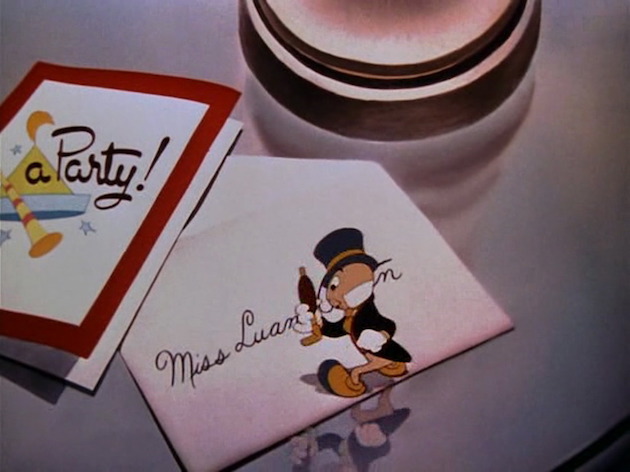
By exploring, I mean both that Jiminy realizes that by one extraordinary coincidence, he just happens to be in the home of Disney child star Miss Luana Patten (and if you are now wondering just what Miss Luana was doing to that doll and teddy bear to make them look that dismal, look, being a child star is tough, ok?) and that, right after making that discovery, Jiminy is going to sneak a look into her mail. Some conscience you are, Cricket. The mail contains a party invitation for Luana—not random crickets—inviting her over to the home of Edgar Bergen, Charlie McCarthy, and Mortimer Snerd, who by an even more extraordinary coincidence, just happen to be living across the street. Jiminy decides to add party crashing to his list of misdeeds—seriously, Jiminy, I’m beginning to think that you’re the one in need of a conscience, and I haven’t even gotten to the later bit where you steal some of Edgar Bergen’s chocolate cake—heading across the street.
If this is striking you as a slightly overcomplicated way to link these two cartoons together, I’ll note that Disney artists seemed to agree: the next two package films completely avoided these sorts of shenanigans. On the other hand, this did allow Disney to showcase Edgar Bergen and his puppets—and allow the three of them, plus Luana Patten, to narrate the Mickey Mouse short. And it allowed Edgar Bergen to have a bit of fun with shadow puppets.
It also allowed the artists to try to play a bit with a few animation and live action techniques—for example, having an animated balloon appear over Mortimer Snerd’s head, as the slow witted puppet tried to imagine the picture Edgar Bergen was painting. As Bergen continues to describe the scene, the background changes, adding every element he mentions. In a later scene, the animators had Edgar Bergen’s shadow puppet of a giant shift into the animated giant, in a smoother transition from live action to animation than the studio had mastered prior to this.
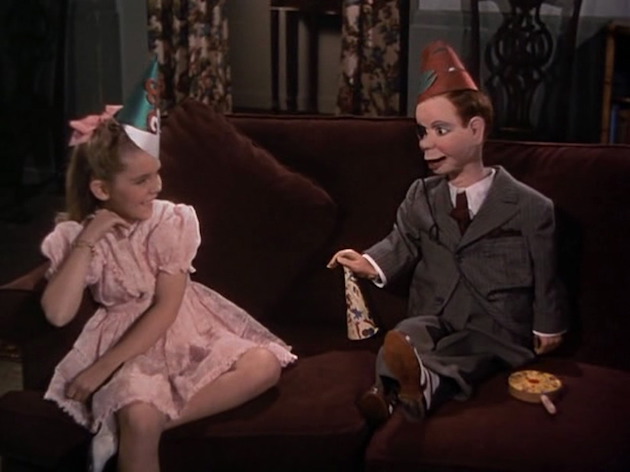
The plot itself is fairly simple: Mickey, Donald and Goofy live in Happy Valley, a place that, thanks to a magical singing harp, is blessed with abundance and happiness—that is, until the harp is stolen. The river vanishes, as does the food—Donald Duck does not deal with this well—and things are not really helped when Mickey decides to trade the cow for some magic beans. That night, though, the beans prove worth it, growing into a giant beanstalk that stretches right into the clouds—ripping apart the house of Mickey, Donald and Goofy as it does. Once in the clouds, the three find a castle, food, the harp and a giant—and must trick the giant to escape and restore the harp to Happy Valley.
The narration isn’t always successful, riddled as it is with clichés, and the animation is hardly up to the best of Disney, with simple backgrounds, and only a few animated characters per frame—by now standard Disney cost-cutting devices. The briefly appearing crows look remarkably like the crows from Dumbo, leading me to the suspicion—a mere suspicion—that they were directly copied/traced from the earlier animation cels. Apart from one glorious moment of bouncing on jello, Goofy is mostly wasted. And plot holes hardly begins to describe several problems here: to take just one, why does the harp’s singing put only the giant to sleep, and not the smaller—and presumably more susceptible—Mickey, Donald and Goofy. Especially given that these are the same three guys who managed to sleep through a giant beanstalk growing through their house, lifting it up into the sky, and ripping their furniture apart.
I’m also just slightly skeptical that no one would notice a giant walking off with the real life Hollywood Brown Derby, but perhaps I’m just overestimating the observation skills of typical Los Angeles residents.
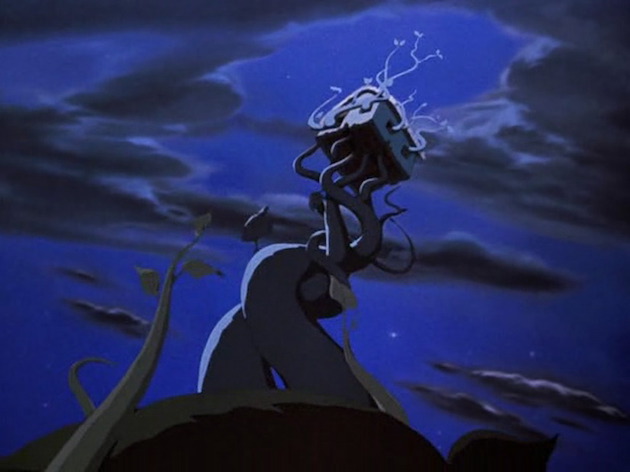
On the other hand, the narration does give us this great moment of understanding from Charlie McCarthy:
“All was misery. Misery. Misery,” says Edgar Bergen gloomily.
“Just like the eighth grade,” cackles Charlie McCarthy.
And the animation gives us other great bits—including that moment of Goofy jumping on giant jello and turning it into a trampoline, which small me thought was very very funny and current me thinks is a remarkably clever animation trick of making an animation cel (the jello) initially look like part of the background. Donald Duck gets to stalk a cow, and Mickey gets some moments in a trickster persona that suits him remarkably well. It might not be the greatest Mickey cartoon ever, but it’s the only Mickey cartoon with Edgar Bergen and Charlie McCarthy, which is something. Those dubious about watching bears slapping each other while country dancing should feel free to fast forward to this bit.
But it, too, does not exactly fit the supposed Fun and Fancy Free theme of the film—although the phrase is dropped into the narration, fairly awkwardly. Not looking around corners, not worrying about the future, and just enjoying the moment—the advice Jiminy pushes on everyone at the beginning of the film—almost gets Mickey, Donald and Goofy killed, and the Happy Valley doomed forever. What does save them? Planning and tricks—and judicious fear of a giant who could very well kill them at any moment. As with the first section, and the introductory bits with Jiminy Cricket, the “Don’t worry be happy,” theme, however much hammered in by the narration, is constantly undercut by what actually happens on film.
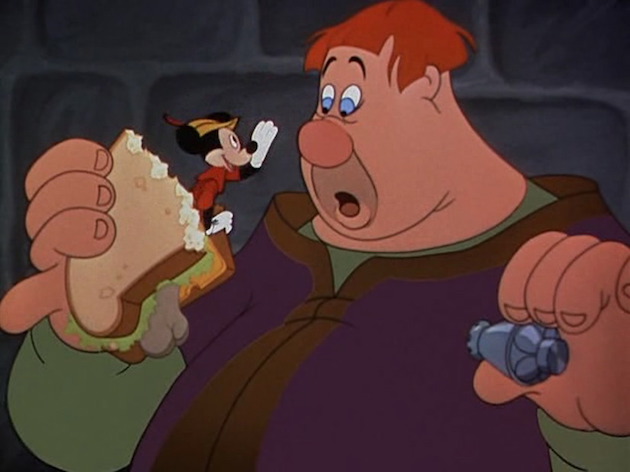
Speaking of Mickey Mouse, though, Fun and Fancy Free is notable for one more thing: it was to be the last time Walt Disney voiced Mickey Mouse. Years of smoking and stress had caused their toll, and as much as Walt felt protective of his major character and star, he could no longer force his voice up into Mickey’s squeaky register.
Despite the presence of Edgar Bergen, Charlie McCarthy, Donald Duck, and Mickey Mouse, Fun and Fancy Free was yet another box office disappointment for the Disney studios. Worse, the two sections were too long to be easily repackaged into separate cartoon shorts and resold, though the shorts were later shown on television—in the case of Bongo with different narration—during Walt Disney’s Wonderful World of Color and The Wonderful World of Disney, and later on the Disney channel, as well as on DVD and—over in the UK, at least—on Blu-Ray. Mickey and the Beanstalk inspired several fine art pieces, both paintings and statues, and several trading pins, and elements from the short appeared in Once Upon a Time. And in the short term, at least, the film helped bring Mickey back into the spotlight.
But the money for a full length animated movie was still not there. Fortunately, concept art—some of it dating back to Fantasia—was, and the studio had a few shorts in production. Perhaps, while animators rushed to finish The Adventures of Ichabod and Mr. Toad, the studio could keep its doors open with another package film.
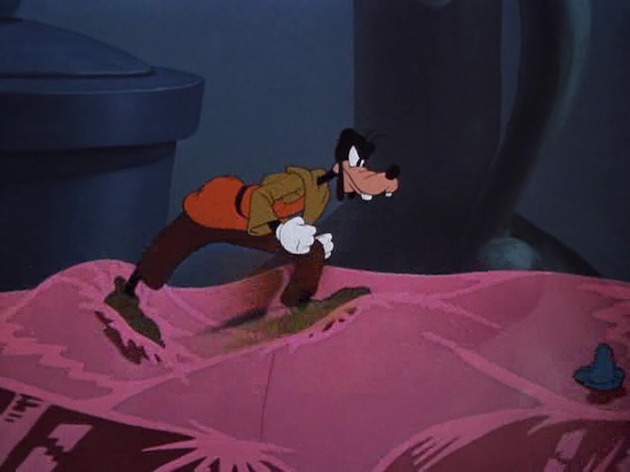
Melody Time, with the bumble bee cartoon that a few of you can’t stop buzzing about (sorry) coming up next.
Mari Ness lives in central Florida.










